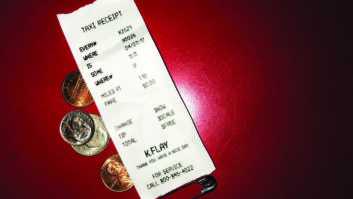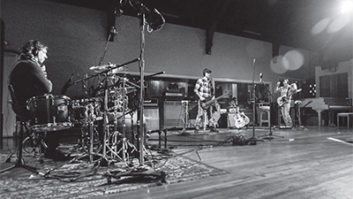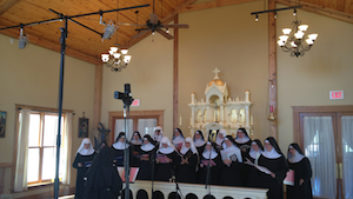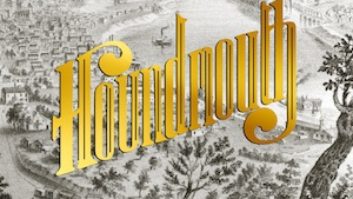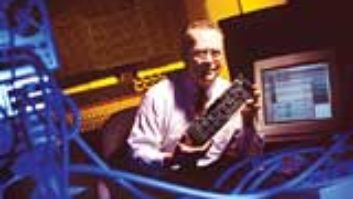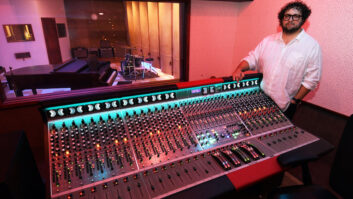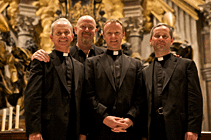
From left: Rev. Eugene O’Hagan, producer Mike Hedges, Rev. David Delargy, Rev. Martin O’Hagan
Three Roman Catholic priests from Northern Ireland who began singing together as teenagers in the seminary—the Rev. Eugene O’Hagan, Martin O’Hagan and David Delargy—have become overnight sensations more than 20 years later. In February 2008, the three recorded a demo that reached the ears of UK-based producer Mike Hedges (U2, The Cure, Dido, the Manic Street Preachers), who was sufficiently impressed to sign on as their producer and convince Sony BMG to fund the trio’s first album, titled The Priests, which RCA Victor released in November 2008.
The CD, featuring sacred and traditional Irish music, was an immediate success, claiming the Guinness World Record for the fastest-selling UK debut for a classical act and surpassing 1 million copies sold worldwide in January. This week, The Priests is Number One atop Billboard’s Top Classical Albums chart.
Hedges co-produced this effort with Sally Herbert and assembled a team of engineers that included Haydn Bendall and assistant Olli Cunningham. The project presented the production team with challenges throughout. For starters, the priests were new to album production. When the O’Hagans and Delargy were asked by CNN about whether they enjoyed the recording process, Rev. Eugene O’Hagan replied, “It’s been hard work. It’s been tough work. We’ve never worked with ‘cans’ [headphones] before. And the whole technological side of recording has been an eye-opener. And for those of us who have never been exposed to that kind of technological world and the advances of science and mixing and recording, it’s been a really fantastic experience.”
Recording sessions for The Priests took place in multiple locales. The production team began the project in a traditional parish hall in Belfast, Ireland—the Good Shepherd Centre, a familiar and comfortable environment for the priests. “We started with a piano- and vocal-only rehearsal to routine the songs,” Cunningham explains. “Then we spent the rest of the time working on tempos, feel and keys using the orchestral arrangements, which were realized using samples running live from Logic Pro 8. The guide vocals were recorded directly into Logic through the Prism Sound Orpheus [FireWire recording interface]. The Orpheus was invaluable as it meant the guide vocal recordings were [of] great quality—some takes were used on the masters.”
Vocal sessions took place at Amberville Studios near Belfast, while the Irish Film Orchestra recorded stems at Windmill Lane Studios in Dublin. Hedges and company then brought the pre-mixed orchestral stems to St. Peter’s Basilica in Vatican City, where they recorded the 54-member Choir of the Philharmonic Academy of Rome in the Basilica’s choir chapel using a 24-bit/96k Pro Tools HD rig with three Prism Sound MMA-4XR mic preamps. “We did three evening sessions, each lasting three hours, in the Cappella Giulia in St. Peter’s Basilica and recorded 15 songs,” Cunningham says. “We had the stems in Pro Tools and the choir’s performances were then mixed with the tracks during the day at the Forum Music Village studios in Rome.
“It was quite a structured approach [laughs], but it had to be done that way,” Cunningham reflects. “There was no other way of getting it.”
In the following Q&A, Cunningham shares his recollections of tracking sessions for The Priests, including the rare recording sessions inside St. Peter’s Basilica.

Mobile recording rig inside of Good Shepherd Centre in Belfast, Ireland
I’ll start with the pre-production phase that took place at the Good Shepherd Centre in Belfast, Ireland. I was wondering about the room that you recorded it in.
It’s an old church hall in a parish center. It’s attached to a church and [has] everything you would expect of a room like that—echo-y, wooden floors, noise.
Did you do anything to adapt to the room environment specifically, or did you just work with it as-is?
We did actually just work with the room as it was. I think the microphones in the photo are 414s from AKG. We did a couple of sessions in pre-production a couple of days there, and on one of the days we used these microphones that Mike Hedges, the producer, is extremely fond of, which is a Sennheiser MZW 4032. Some of them we were using for handheld live mics, and they’ve just got really good sort of effective sound to them. Their rear rejection, although not complete, is quite musical, and they just seemed to work. They were set up with the three priests facing each other, which was essential for their performance. I think the idea was to make them feel as comfortable as possible. At that stage we were just trying to get the arrangements right and anything else was a bonus.
The sound of the vocals was actually pretty amazing, partly because of the microphones, partly because of the way they were set up, but in a large part because of the Prism Sound Orpheus. Obviously, this room is not a controlled environment. It was just really surprising how good it sounded, even in a room [that] was never conceived as a recording environment. [The Good Shepherd Centre] served its purpose perfectly for pre-production, and the bonus was that because it was the first time that these guys had sung with microphones and headphones, and using playback and whatnot, there was a beauty to those finished performances, even when they were just meant to be rehearsals. It was an extremely simple setup—the laptop, a couple of hard drives, a pair of powered speakers, three microphones, a [Prism Sound] Orpheus, and three sets of headphones. The least amount of things could go wrong in that scenario.
Certainly the environment in the parish hall was comfortable for them, as opposed to the environment of a recording studio.
I think it was important for them to feel comfortable with the whole recording process. The first thing we did was get a piano player and then get the three of them standing around the piano, singing through the songs and realizing the orchestral arrangements so that they’d have an idea of what the orchestra might sound like and then sing to that. It really was a gradual step-up process, and then they wanted to do vocals in a proper studio.

Olli Cunningham
How did you come to choose the Prism Sound Orpheus for pre-production?
I had been looking for something different because although I have a [Digidesign Digi] 002, which serves its function, I needed something with higher quality preamps and converters. I’d read about the Orpheus and so I got in touch with Prism and found out a bit more about it, and it just seemed like the perfect thing to use. Obviously, with only the three vocals of the priests to record in pre-production, we were covered by the fact that the unit had the four channels of preamps built in. And because we were flying over from London to Belfast to do this pre-production, luggage and equipment was an important consideration—just take what we needed. I didn’t really know anything else on the market that would have done that job as well, at all. I think I mentioned the monitoring as well. We just had powered monitors set up on one of the outputs, then we’re running the headphones on the other, and that was it! [Laughs] A Mac Book Pro running Logic, a couple of hard drives, the speakers, mics and headphones, and the Orpheus—a perfect portable studio!
After the pre-production phase, you recorded the priests’ vocal tracks at Amberville Studios, near Belfast, Ireland.
The next step was using temporary orchestral backing tracks running live in Logic. Having worn headphones in the Good Shepherd Centre, they weren’t fazed by that [aspect] when they got into the studio. Then the next step was recording the orchestra in Dublin; that was in Windmill Lane Studios, which is a famous Dublin studio. It’s a building full of character, and its main room is big enough to house an orchestra.
How large was the orchestra?
It was around 45 [musicians]. Then [the priests] did a few more vocals back at Amberville, once the master takes had been chosen. Then when everyone was happy with the vocal performance, the next step was starting to mix [the album] in London at The Strongroom. They had the orchestra, the vocals, the vocal reverbs and the stems in the Pro Tools session.
From there, you go to St. Peter’s Basilica in The Vatican to record the Choir of the Philharmonic Academy of Rome.
Yep, with a hard drive and some stems. [Laughs] That was quite a complicated setup. Essentially you’re installing a temporary recording studio in the corridor outside the choir chapel. If you go through the main Basilica, off to the left but open to the main room is this choir chapel. I think it was specifically designed with the choirs in mind. It sounds quite incredible. It even has 25-meter-high ceilings [approximately 82 feet high].
What was the equipment setup like?
It was a 54-piece choir—sopranos, altos, tenors and basses—and the choir was set up in front of the altar on steps. We had two hours to set everything up. They were doing Mass up until 5 o’clock and the session started at 7. We hired a company to provide some of the equipment. They provided Apogee converters and a Pro Tools HD rig, and powered speakers. [We brought] the three sets of Prism [MMA-4XR] preamps. We had a monitoring system—a complete fold-back system for 54 people. So that was pretty complex, as well, getting 54 sets of headphones working painlessly and without error [laughs]. You can imagine doing 15 songs in three sessions for three hours.
Fifteen songs?
Yep. And there wasn’t any room for maneuvering. Those were the three sessions, and that was it. So we realized that the reliability of all the equipment was of the highest importance, and also the design of the system, so that we weren’t losing time because something was going wrong. We all thought very long and hard about that. The recording engineer, Haydn Bendall—who mixed the album and recorded the orchestra and the choirs—was very specific about microphones and obviously the preamps as well, which were ideally suited to that session because you wanted to capture every nuance of the space as well as the performance.
What microphones did you use, and how many?
There were 12 microphones in all. There were [four Neumann] U87AI’s as close mics on the four sections of the choir. There was a pair of DPA 4011-T’s further back. There was another pair of DPA 4006 omnis a bit further back than that. Then there was another pair nearer the back of the room of Schoeps CMC5-MKIV’s. And then just for kicks, we fit two Sennheiser MKH40’s pointing out into the Basilica to capture what seemed to be about a 16-second reverb [laughs], because the choir chapel opens out into the Basilica—it was a massive archway, a huge opening, so the sound of the choir was projecting out there and we were able to capture some of that. And there’s one track where [the natural reverb] was used at the end of the piece and it was extremely effective.
That’s all the reverb you need.
From what I remember, when Haydn was mixing it, it was just a question of balancing all the different mics and—depending on the song, depending on the importance of the choir in that particular piece—he’d use less or more of the close mics, or less of the room mics at the various points that they would pick up. But again, the preamps performed without any error in the whole session, so that’s always rather fantastic.

What sort of preparations went into using St. Peter’s Basilica as a recording space?
Mike Hedges was able to have a look around the Cappella Giulia, and got a mental note of the size and the shape of it, and came back with some suggestions, and then [had] big discussions [with] myself, and Haydn. We sketched out on a piece of paper from Mike’s memory roughly how big it was, how far away the corridor was from the main room, and all of those kinds of calculations. Then we just had to put in place sort of contingencies for lengths of cable and all that kind of stuff, which, luckily because of the thoroughness of our conversations, we got right! It was in a way going in slightly blind. You just have to use the experience of people like Mike and Haydn—Haydn worked at Abbey Road [Studios] for years—just to go, “Right, I think if you take that equipment and use those bits of gear and that way, we’ll be covered.” I think it turned out better than anyone expected. I’m lucky there were no problems.
Once all of that was done and the choir performances were chosen from the best takes, [the choir tracks were] mixed in at Forum Music Village in Rome, and then we got our final master at Metropolis Studios in London.
It sounds like a rare and unique type of project.
Suffice to say, I think it was a unique experience, and certainly one that none of us who worked on the project will ever forget! [Laughs] We felt extremely grateful and thankful to have been a part of it, and it really was a beautiful thing to hear, because that choir singing in that space was really one of the most amazing things I’ve ever heard.
It’s great that the equipment you had on hand was able to capture that moment so well.
Exactly, and I think the key to all this is being really simple about it —what minimum [gear] do we actually need, what’s the most important thing? And the most important thing is the performance, and how do you capture the performance of a choir in the simplest, most effective way? You need great microphones, clean cables and great preamps, and a Pro Tools rig to capture it. And that was what we had.
Matt Gallagher is an assistant editor at Mix.
For more information on Prism Sound products, visit www.prismsound.com, and for more information on The Priests, visit www.thepriests.com/us.
